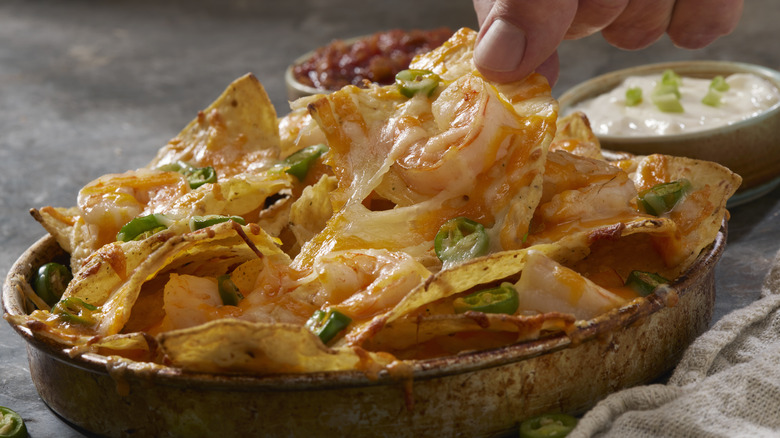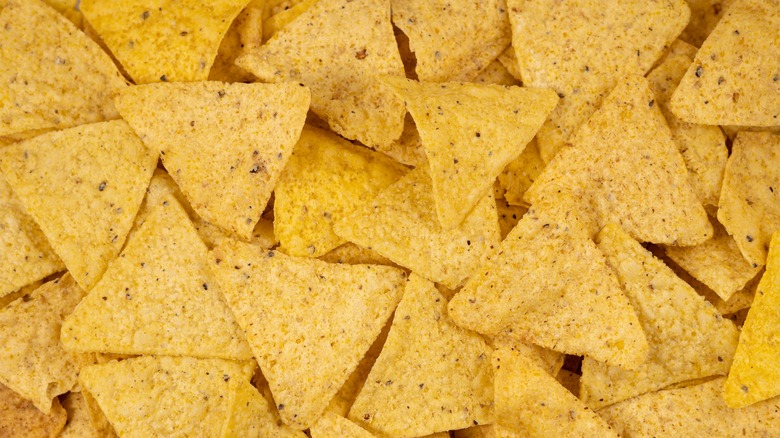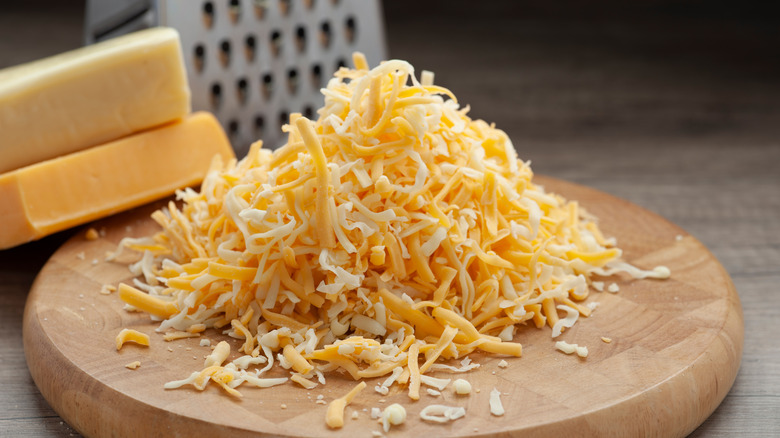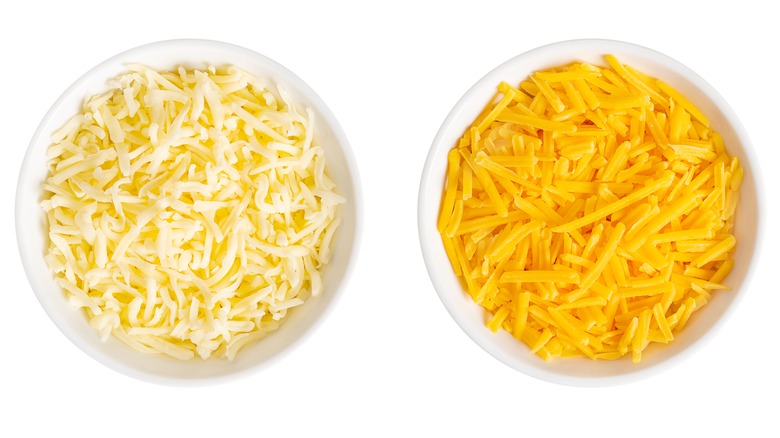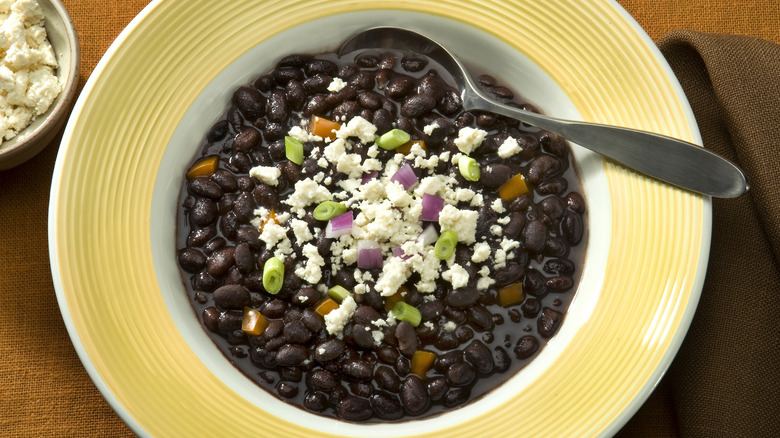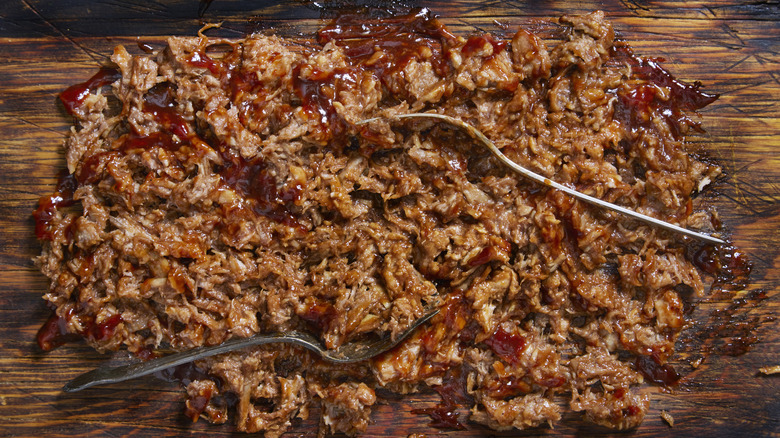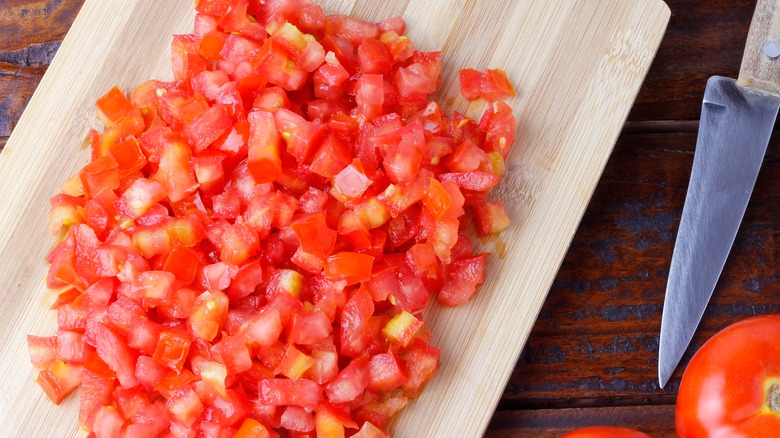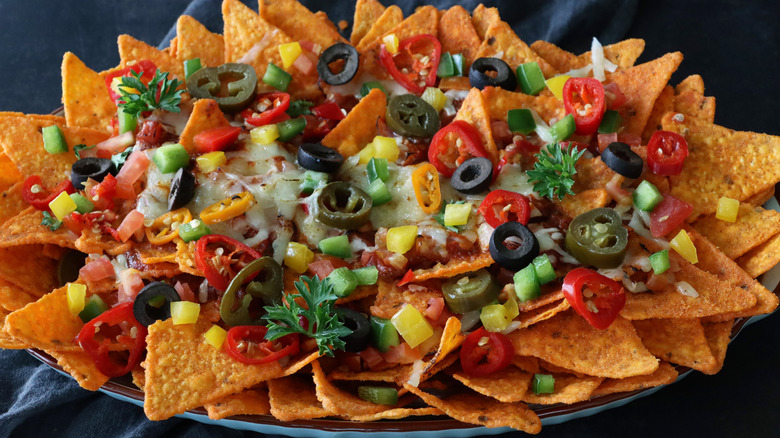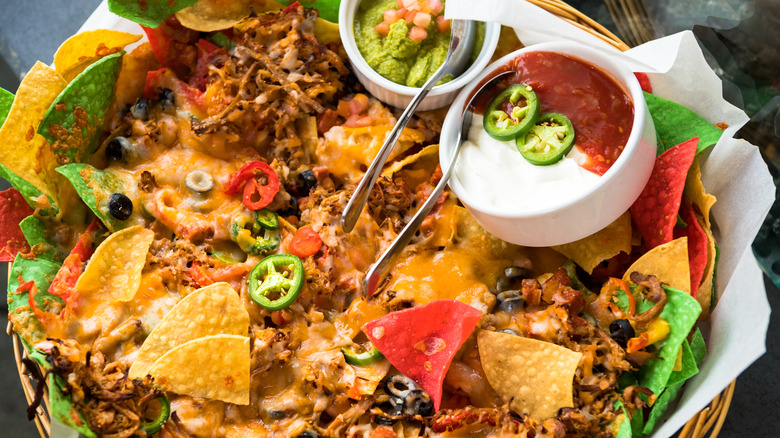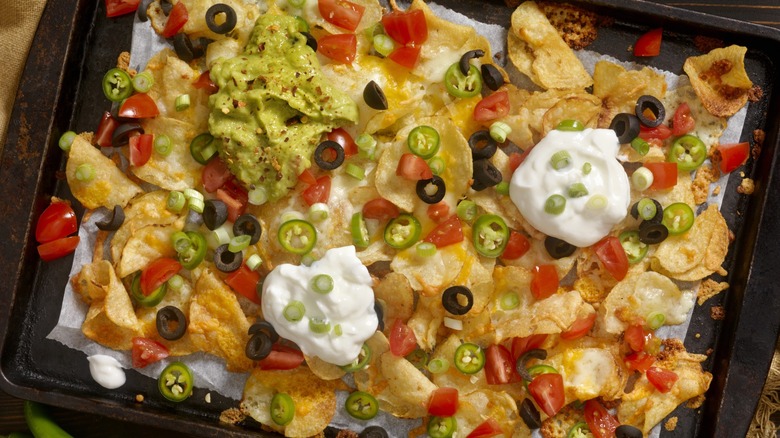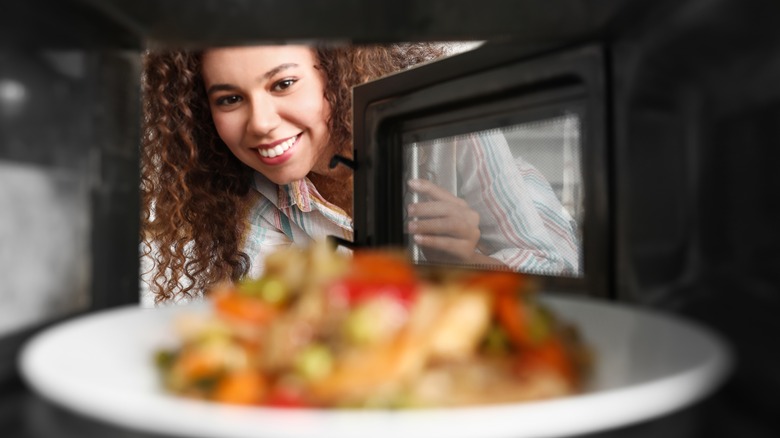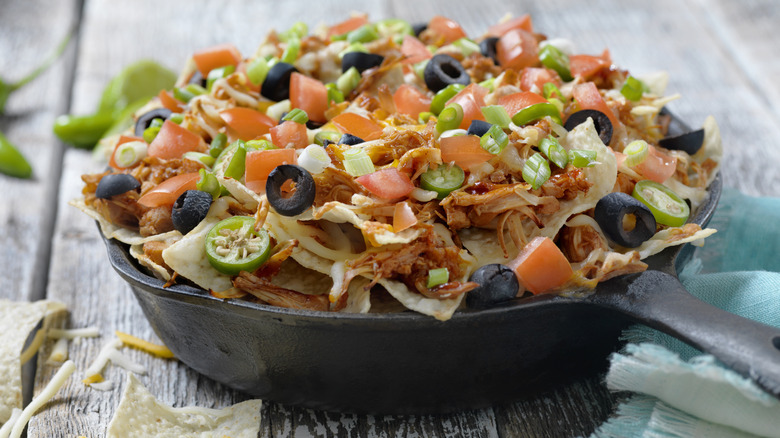11 Mistakes Everyone Makes When Making Nachos
What game day would be complete without a big plate of nachos to tuck into? Nachos are not just the perfect game food, but a great crowd-pleasing option for any gathering — big or small. You can make them to share or as a single-serve portion, with your choice of toppings, and you can eat them with your hands. And as we all know, it doesn't matter how many chip pieces come away when you grab them — it all counts as one nacho.
Nachos are also infinitely customizable. Once you have your crunchy base, you can top them with whatever you want within reason. That being said, there are still some nachos faux pas that you'll want to avoid the next time you're in the kitchen. After all, no one wants a subpar nacho. I have made nachos countless times and experimented with what works and what doesn't, but through trial and error I feel I've almost perfected it. To help you avoid the pitfalls and serve up the perfect platter, here are some of the mistakes everyone makes when making nachos.
1. Using the wrong chips
It might seem incredibly obvious, but the chip is the foundation of the nachos. Without a solid chip, there is no hope for your nachos. You may think that all tortilla chips are created equal, but there is great variety across brands and types that is worth knowing. This does not mean you have to spend lots of money on fancy chips or make your own, though you are welcome to do so.
The main thing you'll want to avoid is thin chips, as these will be unable to hold the heft of toppings that come with nachos. If you use chips that are too thin, you can expect a fair amount of breakage with your nachos. You will also want to stay away from chips that are too small, as, once again, they will not hold up to toppings. Nachos are usually eaten with your hands, so think of the chip as your utensil and choose one that is up to the task.
Finally, while this is somewhat a matter of preference, triangle tortilla chips are usually better for scooping and eating compared to round tortilla chips, which can be awkward to use. It should be noted that you are not tied to the traditional corn tortilla chip for nachos. You can branch out and use a base of pita chips or waffle fries. If you go this route, just remember to keep the structural integrity and shape of the base in mind.
2. Using pre-shredded cheese
After the right choice of chip, the cheese is the next most critical aspect. Other toppings may come and go, but the cheese is non-negotiable — it is the gooey, deliciously melted layer that brings the whole thing together. Sure, using pre-shredded cheese is undoubtedly convenient, but it just doesn't melt the way it should to produce a homogeneous, oozing cheese layer for your nachos.
Pre-shredded cheese is coated with anti-caking agents to prevent all the shreds from sticking together in the bag. This is necessary to maintain the integrity of the individual pieces, but it means that when it comes time to try and cook with that cheese, it will not melt together cleanly.
Whether you are using straight shredded cheese or making a cheese sauce to top your nachos, you are better off buying blocks of your favorite cheeses and grating them yourself. If you are worried about having too much shredded cheese, you can always freeze the extra. Plus, then you will have more ready to go for your next batch of nachos, which is a win in itself.
If you need to use pre-shredded cheese, try to find one with a larger shred, such as Tillamook Farmstyle Shreds, as they will melt better than most.
3. Not using a blend of cheeses
What could be better than cheese apart from more cheese? Trust us, your nachos will be much better if you use a blend of cheese instead of just one type. There is a reason that when you buy pre-shredded cheese at the store for nachos, it is marketed as a "Mexican blend" or "Mexican four cheese." These will often include some combination of cheddar, Monterey jack, Asadero, and queso quesadilla.
Other cheeses can be used as well, and you might want to experiment until you find the best combination. The good news is, since we already discussed that you should shred the cheese yourself, you will have complete control over what cheese is included and in what quantity. If you are unsure where to start, cheddar is a solid base. Cheddar is tangy and flavorful and can provide a pop of color if you get an orange variety.
You also do not have to stick to the cheeses mentioned above. If there is a cheese you know you like, try it. Just remember that mixing cheeses allows you to achieve a more complex flavor, and this makes for better nachos as a result.
4. Adding soupy toppings
The thing that really takes nachos to the next level is the toppings. Otherwise, you just have cheese chips, which, while delicious, are not nachos. Nachos toppings, though, have a habit of being wet and almost soupy, and if you are not careful, adding these soupy toppings on top without any forethought can lead to soggy, floppy nachos that are difficult to pick up let alone scoop.
Take beans, for example. When adding beans, it is important to strain them to remove most of the excess water before topping your nachos — and the same goes for any wet or particularly juicy meat. Even chili should be thick and added with caution, especially if the nachos are going to sit before being consumed.
Brined ingredients such as pickled jalapenos or olives should be drained as well. You don't need to pat them dry necessarily, just ensure they have been drained and you are not adding liquid directly onto your nachos.
Additionally, while you may be tempted to plop some salsa right on top of your nachos, try and resist the temptation. Serve it as a dip on the side to preserve the structural integrity of your creation. Your guests will thank you.
5. Not using seasoned protein
Nachos are all about bringing pops of flavor in a single bite. So don't squander the potential when it comes to your protein. Instead of topping your nachos with straight shredded chicken or boring beef crumbles, boost the flavor with some carefully selected seasonings. Add some dry seasoning, such as taco seasoning, or use a barbecue sauce to add flavor. Just remember that if you are simmering any of your meat in sauce, try to simmer some of the excess liquid out to avoid soggy chips.
Meat isn't the only way to add flavor, and you should also add seasoning to your bean toppings. Beans can be used in addition to or instead of meat, but if beans are going to be your main protein source, you need to make sure they earn their place. There are plenty of recipes out there for fast Mexican black beans that pair well with nachos. Using canned beans as a time-saver is fine, but make sure you are adding spices and flavor to take your nachos to the next level.
6. Cutting toppings too large
Large toppings may look nice on nachos, but they are going to cause problems when it comes to actually eating them. Items such as tomatoes, meat, olives, onions, or anything else should be cut or shredded into small enough pieces that they can be eaten in a single bite. Ideally, they should be small enough that you can get multiple types of toppings in a single bite, with additional salsa or guacamole on them.
This does not mean you have to dice everything super fine. Take fresh jalapenos, for example. You can slice the peppers into ¼ inch rounds, and they will still be easy enough to eat. However, if you are shredding chicken, you do not want to leave big pieces. This is partially because you want to make sure the toppings fit on a single chip. Sure, the cheese helps to hold on awkwardly shaped toppings, but if you have a group of people eating nachos during a football game, you don't want to have to tear your eyes away from the game to keep an eye on unwieldy toppings.
7. Not layering evenly
Layers are key to the construction of nachos, and one single layer just isn't going to do the job. Nachos are great because you can take advantage of both horizontal and vertical space, making them as big or small as you want. With this, though, it is important that your layers are even. You do not want lots of peaks and valleys as this will lead to uneven cooking.
The ideal number of layers is two to three. If you go over this, the center of your nachos and lower layers will not cook as evenly.
By layering nachos, you are ensuring even dispersal of your toppings, meaning that each chip should have something on it. While it will take longer to lay out one layer of chips, add the toppings, then add another layer of chips, and so on, the difference it will make to your nachos will be night and day. Without it, you end up with nachos that are just slightly warmed chips, devoid of the salty, savory adornments they deserve.
8. Forgetting to balance flavors
When making nachos, you can get incredibly creative with toppings. You can use a selection of meats, different spices, and even fruit. You don't have to stick with a Mexican or Tex-Mex style either. Try Greek-inspired nachos or the don't-knock-it-until-you've-tried-it dessert nachos. The options are endless. When experimenting, though, it is important to create balance in heat, texture, and flavor.
For example, if you are making incredibly spicy nachos, try to pair them with a dairy item, such as sour cream, to help balance the heat. Adding acidic elements such as tomatoes and pickled veggies will also play nicely with the heavy, fatty nature of cheese.
Even keeping in mind the balance of the physically warm nachos with the sides you are offering can help. When your nachos are piping hot from the oven, dipping them into some cold and fresh guacamole or salsa will provide a pleasant contrasting temperature and texture. Balancing out these notes will help you develop your own favorite recipes for nachos.
9. Not lining your pan
Prep work may not be the most interesting part of any cooking endeavor, but arguably the cleanup is much worse. If you want to avoid a tedious and exhausting time washing the dishes later on, you will want to spend a little more time on the former.
In this case, we recommend lining your nachos tray. This is especially the case for making large sheet pan nachos. Let's be honest, nachos are messy. They are gooey, the cheese can get toasted onto the bottom, and there are a lot of little pieces that can fall off and get stuck to the bottom of the tray. However, lining your pan in aluminum foil will make cleanup a breeze. You won't have to worry about scrubbing off caked-on food, and instead, you will be able to simply lift the foil off and toss it in the trash. You can also use parchment paper to line your pan instead of foil. Parchment paper is naturally non-stick and will keep your pan clean so you can enjoy a delicious snack without the hassle.
10. Using a microwave
There is nothing you can say that will ever convince us that using a microwave is an acceptable way to make nachos. There are plenty of people out there who recommend it, making this one of the most common mistakes and also one of the most devastating.
The problems with microwaves are twofold: texture and temperature. A microwave will simply never achieve the correct texture. Sure, the cheese will melt, but it will never get crispy or browned, and this negatively affects flavor and texture. After a round in the microwave, the chips can take on a rubbery texture, and the toppings on the edges can dry out.
This brings us to the second problem: temperature. You know how when you microwave something and the outside is hot, but the inside is cold? The same thing will happen to your nachos. While the outside ring of nachos may be melted and cooked, the inside will still be stone cold. Unlike other foods, there is no mixing nachos and putting them back in. You will always either end up with an overcooked outside or an undercooked inside. Stick to the oven, or better yet, the broiler, to get a nice, even, and brown cook. If you have a toaster oven, you can also use that if you want to keep the oven off.
11. Serving them cold
No one wants a cold nacho. If you are making nachos for a party, it is important to scope out your reheating options before the actual event and plan for when they are likely to be eaten. Cold nachos lose their elasticity, and much of the flavor is diminished when chilled.
If you want to warm up your nachos, though, do not be tempted to throw them into the microwave. Instead, if the nachos are already cooked, pop them back in the oven on a low heat of 250-300 degrees Fahrenheit. Cover the nachos with aluminum foil to prevent further browning.
Not only can your wet toppings leave you with soggy nachos, but it also means you can't reheat them if necessary, so keep your salsa, guacamole, or sour cream on the side. You do not want to warm those items up when you warm up the rest of the nachos. This reheating method can also be used in a toaster oven, depending on the size of your nachos.
It can take anywhere from five to 15 minutes to warm up the nachos, depending on size, but in the end, you will have delicious and crispy nachos, ready to go again.
